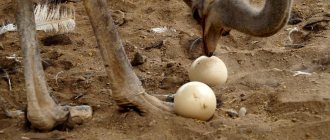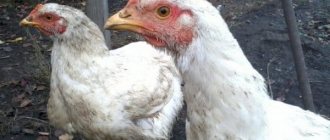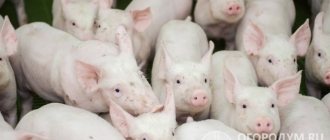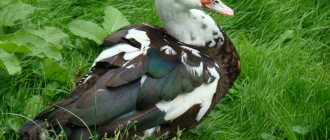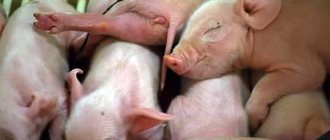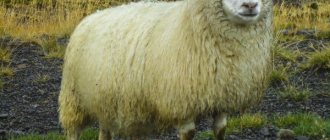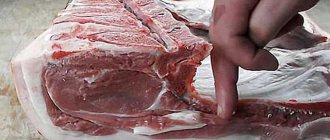Home » Articles about ostriches » How much does an ostrich weigh?
Ostriches belong to the category of flightless birds. They live in the wild and are raised on farms. How much an ostrich weighs depends on the species, gender, age, living conditions and other factors.
Weight of birds in the wild
When talking about ostriches, we usually mean 3 varieties:
- African (African ostrich);
- American (rhea);
- Australian (emu).
According to the biological classification, only the first species belongs to ostriches. Emu and rhea have no relation to this family - they are included in the orders Cassowary and Rhea, respectively. They are called ostriches due to some external resemblance to the African species.
African species
This species is considered the largest of modern birds. The height of an adult is:
- 1-2.8 m – males;
- 0.7-2 m – females.
The birds have a dense build, a long neck, and strong legs. The wings are underdeveloped and not adapted for flight, although their span can reach 2 m. The keel is absent, the pectoral muscles are weak. The skeleton is not pneumatic, with the exception of the femurs.
The average weight of an ostrich is 120-160 kg. Females are smaller - from 63 to 120 kg. The maximum weight on a farm, with proper fattening and quality maintenance, can reach 200 kg; such figures are not typical for the wild.
Females reach sexual maturity at 2 years of age - from this moment they begin to lay eggs (each weighs about 1.5-2 kg). Chicks are born weighing 1.2 kg and quickly increase their weight - by 4 months the figure increases to 18-19 kg.
The weight of the ostrich brain is only 40 g, and 1 eye is about 60 g.
Gorayo
The Somali ostrich was previously considered a subspecies of the African ostrich, but in 2014 it was identified as a separate species. The average adult Gorayo ostrich weighs 100-120 kg, the maximum is 175 kg. The height does not exceed 2.5 m. Female gorayos are larger than males. They lay eggs weighing 1.6-1.8 kg. By the 4th month of life, hatched ostrich chicks grow from 1.2 kg to 20 kg.
Emu
Emus belong to the order Cassowaries and are considered the second largest birds. They live in Australia, grazing on grassy areas. How many kilograms an Australian ostrich weighs depends on gender and stage of development. When laying and incubating eggs, females lose up to a third of their original body weight. The average for birds is 36-40 kg, the maximum is 55-60 kg. Height – 1.5-1.9 m. Chicks weigh 400 g (eggs – 500-600 g).
Nandu
Rhea belongs to the order of the same name and lives in South America. Birds live in groups of 5-30 individuals. How much an adult American ostrich weighs depends on gender - males grow up to 23-25 kg, females are slightly smaller (20-24 kg). Height - 127-140 cm. The birds' head and neck are feathered, unlike the African species. The wings are long. By the age of 3 months, the chicks catch up with their parents in size.
How much does an ostrich weigh?
It is impossible to answer this question unequivocally, since the weight of the bird very much depends on the breed and age. Individuals of some breeds can gain weight up to 250 kilograms or even a little more - this is the largest weight found among birds.
A distinctive feature of the bird is the unusually small brain of the ostrich - it weighs only 10 grams. Moreover, one eye weighs about 5 grams and is larger than the brain. In other words, both eyes weigh as much as the brains. And this - with an unusually huge weight and unusual proportions for birds. It is interesting that the brain is equally small in all breeds.
If we talk about the average weight of an adult bird, then we should consider the performance of several of the most popular species of ostriches. All of them are found in semi-desert areas and savannas of Africa and Australia and lead a similar lifestyle, but their weight can vary quite a lot.
Breeding in captivity
Among all species of ratites, African ones are most suitable for breeding - they have the highest productivity. Hybrids of the Zimbabwean blueneck and African black species are mainly grown. Females reach sexual maturity at 2-3 years, males at 3.5-4 years. Families are formed from 1 male and 2 females.
Oviposition occurs in cycles with a break of 10-16 days. The offspring are hatched by a male and a dominant female. An incubator can be used on farms.
Fattening
During the first week, the hatched chicks do not eat anything, since during this period they are still absorbing the nutrients obtained from the egg. The farmer provides them with fresh water.
From the second week, fattening begins - the ostrich chicks are given chopped grass (clover, alfalfa) and compound feed. Every other day they are offered a chopped egg and low-fat cottage cheese.
From 6 weeks of age, active fattening begins - the following methods are used:
- intensive;
- semi-intensive;
- extensive.
In the first case, ostriches are given compound feed, hay, silage, and fresh perennial grass. There is no free grazing. With the semi-intensive method, the birds are released onto pasture, and the owner additionally provides them with feed, vegetables, and herbs. With the extensive method, pets feed themselves while walking - for 10 birds there should be at least 1 hectare of pasture sown with alfalfa and other herbs (clover, vetch, seradella). They receive additional food in bad weather. In winter, birds are fed using an intensive method.
The feed should include:
- corn and wheat;
- soy;
- cake;
- bone and fish meal;
- chalk and calcium phosphate;
- methionine, threonine, lysine;
- sodium chloride;
- premixes.
For 1 kg of growth, 4-5 kg of feed are consumed. Approximate weight of ostriches:
| Age (in months) | Weight, kg) |
| 1 | 3 |
| 2 | 10 |
| 6 | 60 |
| 10-11 | 100 |
| 14 | 120 |
For feeding, feeders are installed with a depth of 10 cm (length - about 1.2 m). The depth of the drinking bowls is 12-20 cm. The water requirement for 1 adult is up to 10 liters, depending on the weather.
Meat productivity
Birds lay eggs from spring to autumn inclusive - the season lasts up to 8 months, each female gives birth to 40-50 chicks during this time. During the year, the farmer receives about 3-4 tons of meat from this amount. This is better than the performance of a good sow (1.5-2.5 tons). At the same time, fattening ostriches is cheaper - the cost of meat is comparable to turkey and goose.
Poultry is slaughtered when it reaches a weight of 100-120 kg (at 9-10 months). How much an ostrich carcass will weigh depends on the quality of fattening. The share of bones, fat, and lean meat accounts for about 60% of live weight (the average is 58.6%). The farmer receives about 7% leather and up to 1.8% feathers. The rest comes from the insides.
The yield of lean meat from an average carcass is 30-40 kg, mainly leg muscles. In terms of taste characteristics, the product is slightly inferior to beef sirloin, but overall it is very similar to it. Ostrich meat contains up to 49 mg/100 g of cholesterol, 1.7% fat, 21.2 protein. Calorie content of 100 g of product is 98 kcal.
What do all breeds have in common?
Despite the fact that all breeds of this bird weigh differently, they are united by a number of common details:
- The eggs of this bird are truly the largest on the planet . Even in the smallest breed, one scrambled egg is equal to at least 25 chicken eggs. Eggs of all breeds can not only be eaten - they have an excellent taste and a high content of useful and nutritious substances.
- Ostriches cannot fly, but their wingspan reaches two meters. Wings are used during fights between birds, during courtship dances, or to protect chicks. By the way, birds never hide their heads in the sand - this is a myth. When in danger, birds accelerate to speeds of 50-100 kilometers per hour, depending on the breed and age.
- Most predators in the savannah are afraid of ostriches, since an adult bird can break the skull of even a lion with a kick.
- When there is a lack of food in the wild, birds feed on locusts, although this negatively affects their maximum running speed, and when there is a lack of water, they can even drink salt water.
Story
The first written mentions are found in the 16th century in the works of European scientists. Already in the 17th century, emus bred on the eastern shores of Australia.
The history of the origin of the name of the bird is unknown. Similar words are found in Arabic and Portuguese, where they are translated as “huge bird.”
Some scientists believe that the ostrich from Australia got its name because of its piercing cry.
The first scientific description was made in 1789 by ornithologist John Latham in his work A Voyage to Botany Bay. Then there were 6 varieties of emu, but almost all of them were destroyed by the indigenous people due to the struggle for food.
Today, three subspecies are conventionally distinguished, differing in the territory of distribution and the appearance of males and females.
Big moa
Moas, ancient relatives of the ostrich, are no longer found. But they lived on Earth relatively recently. Their homeland is New Zealand. They were divided into three families, represented by 9 species.
The largest - the large moa - reached a height of more than 3.5 m and weighed 250 kg. They are surprising in that they did not have wings or even rudiments. They laid huge eggs weighing 7 kg.
Moa became extinct in the 16th century. But there were rumors that these representatives of the fauna were seen much later - at the beginning of the 19th century. However, the information was not confirmed.
Reference. People in ancient times were no less cruel to the animal world than modern earthlings. Thus, when people appeared on the island, there were about 40 thousand individuals of large moas.
In 1986, in the homeland of the ancient giants, researchers found the paw of a huge bird that looked quite fresh. At first it even seemed that its owner had died relatively recently. But when the remains were examined, it turned out that it was the mummified leg of a large moa.
Slaughter
How are ostriches slaughtered for meat? - difficult. Compared to a chicken, this bird looks like a dinosaur. And the “dinosaur” needs to be caught, stunned, and only then beheaded.
The individual must trust the owner, otherwise, frightened, it will run away, breaking down the fence boards with its strong legs. For this reason, they are not slaughtered on the farm, permanent habitat and walking areas.
A special room with thick walls is suitable for these purposes. Under no circumstances should you slaughter them in a pen with other birds, otherwise you may make enemies among them. Other birds will lose trust, become frightened and experience severe stress.
In order to behead an ostrich, you will need:
- Hammer;
- Knife;
- Rope;
- Metal hook;
Device with electric current supply (for large farms).
- The first stage is beheading. The most important thing is to hit the head correctly (in the middle) with a hammer to stun it so that the ostrich falls unconscious. For this, equipment with current supply is also used: 250 watts are applied for 6-7 seconds. This device is used on large farms. It can kill up to 7 birds at once.
- Next, after stunning, the bird is beheaded with a sharp knife, after cutting the jugular vein in the neck. The carcass is hung upside down on a hook so that the blood comes out. Opening the main artery near the heart will speed up the removal of blood.
- The second stage is cleaning of feathers. They can also be sold.
- The third stage is skinning. Very carefully, with a sharp knife, remove from the toes up through the thigh, try to remove in one or two flaps, without chopping. If you don’t have the skill to do this, you can turn to experienced breeders for help.
- The last stage is the actual cutting of the carcass. The carcass is quartered or butchered according to the principle of processing chicken. Place in plastic bags. Store refrigerated for up to 5 days, frozen for up to 6 months.
Before realizing your dream of owning an exotic bird, it is advisable to undergo training on a farm; fortunately, many farms now provide training services in the care and maintenance of pets.
It would be a good idea to study specialized literature on your own. The main thing is that you enjoy this activity. You need to have patience and dexterity to make your favorite business also profitable.
Savannah
The structural features of the bird and the lack of the ability to fly, which is compensated by very fast running, force ostriches to choose for living flat areas covered with grass (savannas) and, much less often, open forests, which, as a rule, border on savannas.
Ostriches breed on the savanna plains, where there is always enough food for parents and chicks. A healthy bird in such conditions is practically inaccessible to predators, since, noticing them from afar, ostriches very quickly move to a safe place, leaving no chance for the pursuer to catch up with them.
In the savannah, the ostrich lives in flocks of up to 50 individuals.
Most often, ostriches graze near herds of antelopes and zebras, as this provides them with additional protection. In such a situation, sneaking predators are noticed more quickly, and they will also quickly prefer an antelope to a bird, which is almost impossible to catch.
It is quite comfortable for a person to live where ostriches live, and therefore it is not uncommon for local tribes, in addition to ungulates, to hunt birds, which provide a large amount of high-quality meat. Because of their attractive feathers, ostriches in nature were exterminated by humans for a long time. Today in Africa, feathered giants are not considered an endangered species.
Australian emu
The habitat of such an ostrich is in bushy or grassy areas. The once large population became much smaller with the advent of European settlers in Australia. These birds are currently protected at the national level.
Australian birds are inferior to their relatives from Africa; they begin to incubate eggs after gaining a mass of 55 kg. The basis of the diet is leaves, grass, and fruits. With the onset of winter, emus begin to feed on insects. These ostriches can swim well, and while running they reach a speed of just over 50 km/h.
Emu
Adult birds reach a height of about 2 meters, with a maximum weight of 60 kg. The average weight of a chick is 0.4 kg, sometimes a little more.
From the history…
It is believed that ostriches appeared on the planet 12 million years ago. And the trade in the feathers of these animals dates back to the early Egyptian civilizations and goes back three thousand years. In some countries, even before the beginning of our era, animals were kept in captivity. In Ancient Egypt, noble ladies rode ostriches to festive ceremonies. Animal feathers became in great demand at the beginning of the nineteenth century, which led to a significant reduction in the number of birds. In the middle of the century, a period of rapid development of ostrich farming began. The first farm in Africa appeared in 1838. Animals were bred solely for the purpose of obtaining valuable feathers. For example, in South Africa at that time, the export of feathers was in fourth place after the export of gold, wool and diamonds.
Gradually, ostriches began to be bred in captivity in other countries and on other continents: in the USA, Algeria, Egypt, Australia, Italy, Argentina, New Zealand. But during the period of two world wars, this type of business almost ceased to exist, and the number of farms decreased significantly.

